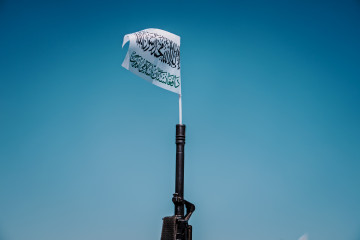
In Afghanistan, can the Taliban defeat IS-K by itself?

On 26 April, US officials reported that the Taliban had killed the senior Islamic State in the Khorasan Province (IS-K) operative who orchestrated the shocking attack on the Kabul airport in August 2021 that killed about 180 people, including 13 US service people.
The attack against the operative reportedly took place in southern Afghanistan in early April, as the Taliban has upped its efforts to wipe out IS-K’s senior leaders and quell its growing threat.
While the Taliban has apparently gained the upper hand in its efforts to counter the group, the violence that IS-K poses is far from over. The faction has sought to disrupt the Taliban’s goals of providing concrete governance and salvaging the country’s dire economic straits.
It has also adapted to the Taliban’s increasingly sophisticated counter-terrorism campaigns, carrying out fresh assassination attempts on leading Taliban figures. This has sparked concerns not only of continued attacks within the country but externally too.
"Despite the group being weakened from its original peak in 2016 due to counter-terrorism efforts, IS-K apparently gained a new lease of life after the chaotic US withdrawal in 2021"
"The US has announced that the Taliban killed the mastermind of the Kabul airport bombing, though it is unclear whether he is one of the deceased or someone else. These losses would constitute a significant blow to the organisation, yet they are unlikely to halt ongoing IS-K attacks due to the decentralised nature of their campaign,” Ibraheem Bahiss, Afghanistan analyst at the International Crisis Group, told The New Arab.
Since its formation in 2015, IS-K has staged numerous attacks on Afghanistan, with its violence spanning across Pakistan and Afghanistan. It has capitalised on local grievances and soaring poverty while exploiting ungoverned spaces, recruiting locals, ex-prison detainees, Taliban defectors, and even foreign fighters into its ranks.
The group is responsible not only for having targeted the Taliban and former US and NATO assets, but also for committing some of the most heinous acts in Afghanistan, including attacking maternity wards, hospitals, girls' schools, and killing pregnant women and nurses.
Though the connection between IS-K and Islamic State Central (ISC) is not completely clear, open-source reports suggest ISC played a role in guiding and establishing IS-K in its early years, while it also transferred funds to the IS offshoot, according to a report by the Combating Terrorism Centre.
In terms of divergences with the Taliban, the faction has denounced the Taliban’s form of ‘nationalism,’ as opposed to its own vision of establishing a cross-border caliphate. It has also accused the Taliban of ‘apostasy’ for accepting investment and humanitarian aid from ‘infidel’ or enemy governments – including China, the US, Iran, and others.
Despite the group being weakened from its original peak in 2016 due to counter-terrorism efforts, IS-K apparently gained a new lease of life after the chaotic US withdrawal in 2021.
A US State Department report published in February said as of 2021, IS-K remained “a resilient enemy with roughly 2,000 to 3,000 fighters, although precise estimates are hard to determine”.
“IS-K has for now given up on waging a guerrilla war against the Taliban, as it recognises it does not have the strength to take them on successfully,” Antonio Giustozzi, senior research fellow at the Royal United Services Institute, told The New Arab.
|
|
“Instead, it focuses now on a campaign of terrorist attacks and on building or maintaining underground networks,” he added. “The Taliban are coping by expanding their intelligence networks.”
As it currently has limited resources, the faction has focused on high-profile attacks to gain significant media coverage, including on leading Taliban officials and foreigners. IS-K had targeted many groups, including the Taliban, government and military officials, religious minorities, foreign aid organisations, and US and NATO forces, often with a high success rate.
Yet in recent months, particularly in the aftermath of the US withdrawal, IS-K has shifted to targeting assets of countries that have sought to build relations in Afghanistan since the Taliban’s takeover, like China and Russia.
Such moves aim to cripple the Taliban’s rule in Afghanistan and hinder its abilities to contain IS-K, particularly as the Taliban seeks international recognition and investment to salvage the economy. For now, however, the Taliban has been able to contain the group’s expansion, while its own efforts have become increasingly advanced.
“The Taliban's counterinsurgency against IS-K has shifted significantly. The Taliban's initial response was highly indiscriminate, using communal profiling against Salafists,” explained Bahiss.
"With the Taliban continuing to struggle with international isolation, there are concerns that the Taliban alone may not be able to fully contain IS-K in the long term"
“Over the past year, Taliban security forces have displayed a tendency to carry out highly precise raids against IS-K hideouts across Afghanistan - suggesting that the Taliban's intelligence gathering capacity might have increased markedly,” he added.
“Since IS-K’s killing of Mohammad Dawood Muzammil, the Taliban's governor for the Balkh province, the Taliban's raids against IS-K hideouts have gathered pace, suggesting that the renewed focus on the IS-K threat might be driven by the highest echelons of power within the Taliban,” Bahiss said.
While the Taliban has indeed weakened IS-K, there are some questions that it may have exaggerated the success of its counter-insurgency efforts while having downplayed the faction’s threat. With the Taliban continuing to struggle with international isolation, there are concerns that the Taliban alone may not be able to fully contain IS-K in the long term.
Renewed fears over IS-K’s abilities to carry out cross-border attacks have also arisen. In March, US Central Command’s General Michael Kurilla said the group will be able to attack US or Western interests “in under six months with little to no warning," adding that these would most likely occur in Europe or Asia.
While earlier US predictions of an imminent attack from IS-K have not come to fruition, such as the Pentagon warning in October 2021 that attacks could come within six to 12 months, US officials have insisted that attacks from the group could still happen.
“There is a real fear that IS-K will carry out attacks outside Afghanistan in order to garner international attention and undermine the Taliban's claim of not letting Afghanistan become a safe haven for transnational groups,” said Bahiss.
As IS-K analysts Amira Jadoon and Andrew Milnes observed, any US counter-terrorism efforts would likely be short-lived and ineffective without any solid regional framework, adding that the Taliban alone would struggle to defeat IS-K.
Instead, they argued, regional countries including China, Russia, Pakistan, and Iran, which hold stakes in Afghanistan’s future along with their own economic aspirations there, are more likely to address IS-K’s presence in the hopes of providing stability.
Jonathan Fenton-Harvey is a journalist and researcher who focuses on conflict, geopolitics, and humanitarian issues in the Middle East and North Africa.
Follow him on Twitter: @jfentonharvey
![Taliban police soldiers deploy on a security patrol in Kabul, Afghanistan, on 2 September 2021. [Getty]](/sites/default/files/styles/large_16_9/public/1235143361.jpeg?h=790be497&itok=9Xhl9xIP)



 Follow the Middle East's top stories in English at The New Arab on Google News
Follow the Middle East's top stories in English at The New Arab on Google News


